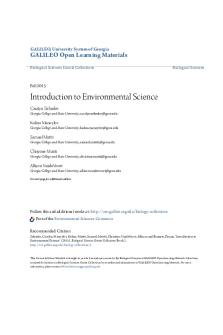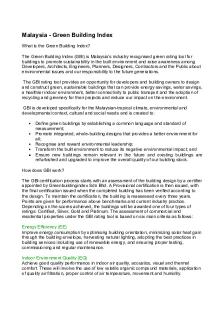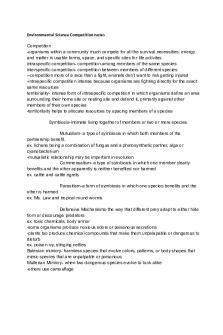Environmental Science Review Sheet PDF

| Title | Environmental Science Review Sheet |
|---|---|
| Author | anam malik |
| Course | Our Planet In The 21St Century: Challenges To Humanity |
| Institution | Queens College CUNY |
| Pages | 19 |
| File Size | 177.1 KB |
| File Type | |
| Total Downloads | 39 |
| Total Views | 162 |
Summary
Download Environmental Science Review Sheet PDF
Description
Environmental Science Review Sheet Lecture 8: Atmosphere What is the Atmosphere -Thin layer of gases that surrounds the planet and makes life possible on Earth Atmospheric Resources(Earth’s atmosphere is arguably the most important medium for life) •AIR: Oxygen for Respiration, Carbon Dioxide for Photosynthesis •Climate (Winds, Weather, Precipitation) •Warmth (Greenhouse Effect) •Protection from UV, Radiation •Allows Light Through for Photosynthesis Layers of Atmosphere •Troposphere : Lowest layer –Up to 10km – Temperature decreases with height – Contains most moisture in the atmosphere – “Weather” occurs here •Stratosphere : 10km – 45km –Temperature increases with height –OZONE LAYER is here -Traps UV Radiation –Thinner air, planes fly here •Mesosphere : 45km - 80km –Again the temperature decreases with height, VERY THIN AIR •Ionosphere/Thermosphere : 80km – 500km –Temperature increases with height due to ultraviolet radiation –This layer is filled with charged particles •Exosphere = Space Stratosphere- Ozone Hole Troposphere – Greenhouse Effect Notes on the Temperature Profile •Near the ground, temperature decreases with altitude –typically about 3ºF per 1000 feet, or 6ºC per km –inherently unstable: cold on top of hot®mixing •At top of troposphere, get a temperature inversion in the stratosphere –inherently stable: hot air on top of cold air Wind – “The solution to pollution is dilution” Higher wind speeds: –dilute concentrations of pollutants –create more turbulence à increase mixing Atmospheric Circulation •Uneven Heating from the Sun •Warm Air Rises, Cool Air Falls •The Earth Spins à Coriolis Effect (Wind to Right in North, Left in South) •Leads to Wind Patterns, Movement of Pollutants •Trade Winds, Doldrums, Jet Stream Atmospheric Stability
-Want to allow pollution to rise and disperse – need MIXING Mixing depth -vertical depth of convection layer in atmosphere •Higher mixing depth à Better air quality •Stable air à shallow mixing depthà bad air quality Radiation Inversion •Caused by cooling of Earth at night •Usually only last...
Similar Free PDFs

Environmental Science Review Sheet
- 19 Pages

Environmental Science Midterm Review
- 17 Pages

Environmental Science
- 16 Pages

Environmental Science Module 1
- 4 Pages

Environmental Science and Engineering
- 109 Pages

Environmental Science Questions
- 52 Pages

Environmental Science Lecture notes
- 25 Pages

Environmental Science English Only
- 10 Pages
Popular Institutions
- Tinajero National High School - Annex
- Politeknik Caltex Riau
- Yokohama City University
- SGT University
- University of Al-Qadisiyah
- Divine Word College of Vigan
- Techniek College Rotterdam
- Universidade de Santiago
- Universiti Teknologi MARA Cawangan Johor Kampus Pasir Gudang
- Poltekkes Kemenkes Yogyakarta
- Baguio City National High School
- Colegio san marcos
- preparatoria uno
- Centro de Bachillerato Tecnológico Industrial y de Servicios No. 107
- Dalian Maritime University
- Quang Trung Secondary School
- Colegio Tecnológico en Informática
- Corporación Regional de Educación Superior
- Grupo CEDVA
- Dar Al Uloom University
- Centro de Estudios Preuniversitarios de la Universidad Nacional de Ingeniería
- 上智大学
- Aakash International School, Nuna Majara
- San Felipe Neri Catholic School
- Kang Chiao International School - New Taipei City
- Misamis Occidental National High School
- Institución Educativa Escuela Normal Juan Ladrilleros
- Kolehiyo ng Pantukan
- Batanes State College
- Instituto Continental
- Sekolah Menengah Kejuruan Kesehatan Kaltara (Tarakan)
- Colegio de La Inmaculada Concepcion - Cebu







